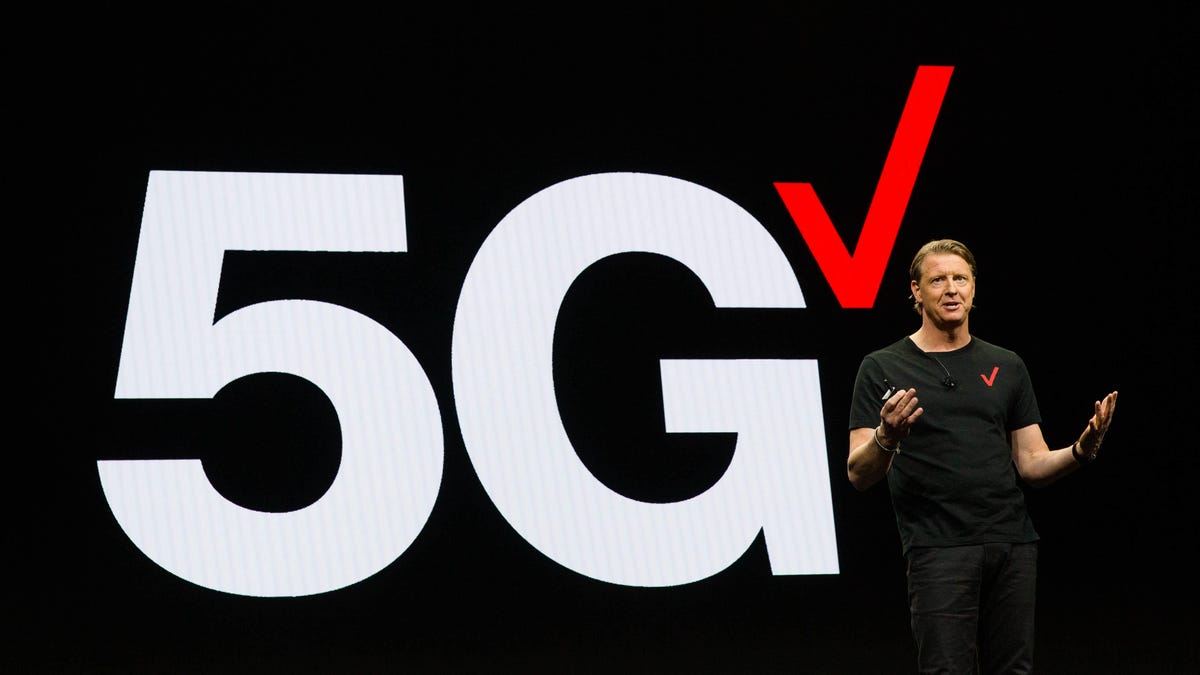Verizon's home internet service will reach 20 million thanks to big 5G upgrade
Verizon's fixed-mobile service uses a combination of 4G LTE and 5G, and will target the largest markets outside of its Fios territory.

Verizon's expansion of its 5G network on Jan. 19 won't just increase speeds on the go. The carrier has also been increasing its coverage for home internet , and in two weeks, coverage will extend to nearly 20 million customers, Chief Technology Officer Kyle Malady said in an interview on Tuesday.
The update is an increase from the carrier's previously stated plans to offer home internet over 4G LTE or millimeter-wave 5G to 15 million customers by the end of 2021.
Verizon's home internet service translates the mobile network signals to Wi-Fi, allowing folks to get the same high speeds they experience on the go on their computers, TVs and other home devices. The expansion of the carrier's 5G service with the activation of the so-called C-band frequencies on Jan. 19 will allow more customers to access those speeds as part of a home internet service.
The wider reach of its home internet service potentially gives millions of customers an additional -- or even first -- option for broadband service, something millions of Americans still don't have access to. Verizon's upgrade also allows the company to catch up with rival T-Mobile , which has already been using a similar frequency of spectrum and has rolled out its own 5G-based home internet service over the last year.
When connected to 5G Home, what Verizon calls its home internet service that is available over 5G, the carrier says that people can expect "typical" download speeds around 300 Mbps and peaks up to 1 gigabit per second. These are comparable to the speeds offered by the wired fiber-optic Verizon Fios service.
Verizon has no data caps for its home internet service, and taxes and fees are included in its starting price of $50 per month (with automatic payments enabled). To attract subscribers, the carrier has been bundling a host of perks, including Google Nest devices, price lock guarantees and even a free first month of service. On Tuesday, it added a new incentive for those with its Do More, Play More or Get More wireless plans, allowing them to save 50% on the monthly cost of 5G Home if they have both services.
The perks show the long road Verizon has ahead as it looks to add 5G Home customers. The service had around 150,000 subscribers split between consumers and businesses, Verizon executive vice president Matt Ellis said during the carrier's third-quarter 2021 earnings call (PDF transcript).
The expanded 5G Home customer base will be spread across many of the country's largest cities included in the C-band rollout, including Los Angeles, Chicago, San Francisco, Seattle and Miami. The coverage will also expand over many (but not all) of the 46 partial economic areas, or PEAs, that are covered by Verizon C-band, mmWave and 4G LTE networks.
More cities and PEAs will be added over time, though Verizon did say that the service won't come to areas where it already offers wired Fios high-speed internet. The carrier hasn't announced plans to offer its wireless internet service to households that are in areas with Fios but don't have access to it, as currently, only one market in the Niagara Falls/Buffalo, NY area offers both home connectivity services.
Along with AT&T , Verizon had previously expected to flip the switch on C-band on Jan. 5, but both agreed to a last-minute deal with the Federal Aviation Administration to delay its activation for two weeks. In that time, all parties will address concerns that the 3.7-3.8GHz frequencies used by the carriers in their C-band 5G networks might interfere with aviation instruments.
Even after announcing the delay, Verizon updated its timetable for bringing C-band 5G to 100 million customers and now says it plans to hit that mark when it goes live in January, up from its original goal of March.
On Jan. 19, Verizon Home 5G coverage will extend to many of the 900 cities within 46 PEAs that are not already covered by Fios, which are listed below:
- Los Angeles
- Chicago
- San Francisco
- Dallas
- Miami
- Houston
- Detroit
- Orlando, Florida
- Cleveland
- Phoenix
- Seattle
- Minneapolis-St. Paul
- San Diego
- Portland, Oregon
- Tampa, Florida
- Sacramento, California
- Pittsburgh, Pennsylvania
- St. Louis
- Cincinnati
- Las Vegas
- Salt Lake City
- San Antonio
- Jacksonville, Florida
- Kansas City, Missouri
- Indianapolis
- Nashville, Tennessee
- Virginia Beach, Virginia
- Fresno, California
- Austin, Texas
- New Orleans
- Columbus, Ohio
- Milwaukee
- Oklahoma City, Oklahoma
- Birmingham, Alabama
- Syracuse, New York
- Charlotte, North Carolina
- Raleigh, North Carolina
- Little Rock, Arkansas
- Brownsville, Texas
- Harrisburg, Pennsylvania
- Albany, New York
- Greenville, South Carolina

